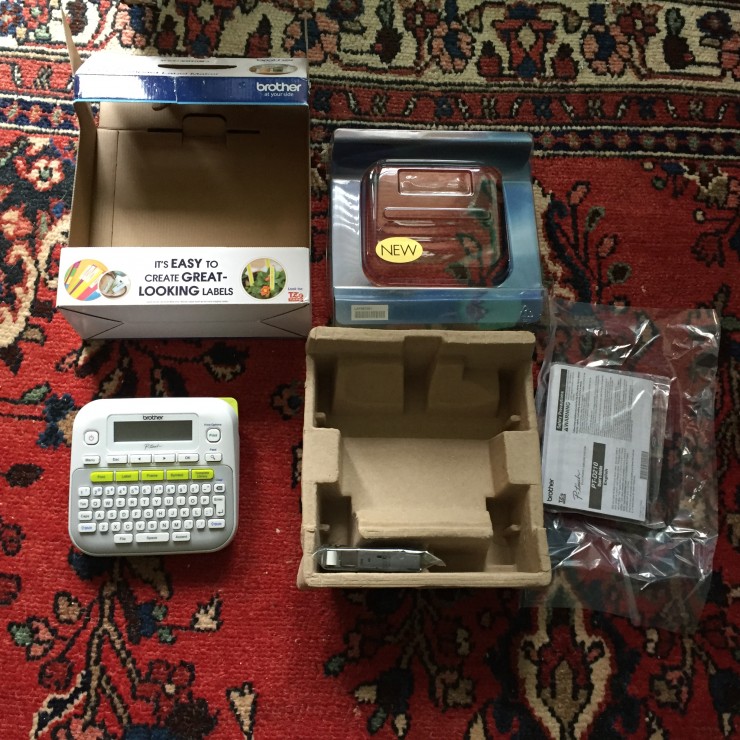I have had quite the backlog from what is informally referred to as “Returnuary“, and invariably, I found a lower cost product, a Brother PT-D210 label maker.
Well, yesterday, I finally got to that lovely little label maker, only to open the box and notice that the customer didn’t return everything. Take a look for yourself and see if you can identify what is missing.

Cue the Jeopardy Music
Can you tell what’s missing? I’ll give you a clue – the PT-D210 does not run on batteries…
Ok, I won’t hold you in suspense any longer – Its the power adapter! Of course, I’m looking at this and thinking to myself: Why would someone steal a power adapter? But it makes perfect sense. They are specific to a limited number of units, why buy a new one for $9.99, when you can buy a new label maker, take the adapter, and send the rest back in for a full refund, right?
Why I Always Inspect Returns
Well, first of all, it is common sense. Anytime you get something from Amazon, you should inspect it, to make sure all parts are there, and that it is legitimately what you sent in. If you do commingled inventory, well, you might get a mishmash of things, but if you do non-commingled inventory (which I recommend), then you should be getting the same product you sent in, back.
What to do if not all parts are there
Of course the simplest answer is often the right one. Document what is missing, document the return / removal documentation, including, if there was a removal packing slip, and then submit a case to Amazon. Much like asking for a gesture of goodwill, you want to keep things short and to the point. When I get around to submitting a ticket, I’ll likely go short and sweet, here’s the product, here’s the removal order, here’s what’s missing and approximate value. That’s it.
Wrapping Up
Returns are part of the game whenever you resell. But, returns should be in good faith, in that the products should have all the necessary pieces included. When they aren’t, its incumbent on the seller to highlight what is missing. Amazon usually does a great job at making a seller whole. Its a shame, because I’m not sure that they actually go after the buyer. Far too many times, I’ve had buyers do things that span the gambit between absent mindedness, like this case with the PT-D210, and outright stealing, such as a case where a product was returned pretty much stripped to the plastic, even a motherboard was missing. So my advice: Always inspect returns, and do it very soon after you receive them. You should have between 9-18 months to actually put in a ticket, but, why leave something for tomorrow, when it can be done today?
Please share your return stories in the comments.
I had a apple watch returned the box had everything but the watch. Sent pics to Amazon got a refund in few days.
Hope you get compensated for the missing brick. I’m surprised the buyer didn’t take the tape, since that’s more valuable than the labeller (unless it is the starter kind). I stay away from Brother labellers, the competition is high as is the return rate. I’ve never made more than a buck or two. Are you having better luck?
@Dave – I think the tape is a starter one…
If I’d gone by my very first FBA sale, I would never have stayed in the game. First sale was a Galaxy pad, which I had to sell as refurbed, not having checked first to see that I was gated from selling as new.
But I’d bought cheaply enough that I still made a profit, so I was pumped. Until it was returned, nearly immediately.
I had sent to me, and it showed up in an Amazon box, unboxed, with nothing but the pad itself. Which may or may not have been the pad I sold, because, with no power cord, how was I to know?
Ultimately, I got back 50% of the then current full retail value, which was about $25 less than I’d spent for it. Total loss was about $40.
Luckily for my future as a seller, I’d already had some solid sales between the return and the arrival of the not-what-I’d-sent.
Since then, the only return I’ve had that was non-sellable was a fitness watch that returned in a jewelry box. Amazon seems a bit better on their game on it, now, though. They paid for it being “damaged by buyer” even before I requested the return.
9-18 months to submit a ticket? I thought it was 90 days. Woohoo! I have some stuff from last fall that I didn’t think to argue, but I now feel that if it is returned to me in a condition where I can’t even return it to the retailer I bought it from, I should give it a shot. I figure they make enough fees off me on stuff that gets returned as “defective” that isn’t.
P.S. – Awesome DO in Baltimore, thanks! I’m moving my game beyond just store and portal rewards as profit thanks to stuff covered there 🙂
@MMKate – I’m pretty sure it is at least 9 months. So definitely have at it. I would just caution, don’t put too many cases in at once.
A little OT–those notices that you can’t send X product d/t too much inventory are apparently part of a pilot program. So, if one of your listings generates that notice–it’s just dumb bad luck.
@MickiSue – Interesting… I hadn’t realized that. Thanks for sharing!
Pingback: A Dark Time for Amazon Sellers - Tagging Miles